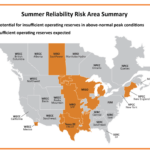The Electric Reliability Council of Texas (ERCOT) on April 13 urged Texans to conserve power as grid conditions tightened owing to a “a combination of high generation outages typical in April and higher-than-forecasted demand from a stalled cold front over Texas.”
The Texas grid operator, which in February narrowly avoided system collapse as Winter Storm Uri bore down on the state, on April 12 issued an operating condition notice for a “projected reserve capacity shortage for hours ending 14:00 through 21:00.” At 3:58 p.m. CST on April 13, it then deployed its responsive reserve (RRS).
RRS is an ancillary service that provides operating reserves to “arrest” frequency decay within the first few seconds of a “significant frequency deviation” on the transmission grid using primary frequency response and interruptible load, the grid operator says. The service, which is not uncommon, also helps restore frequency to its scheduled value to return the system to normal. RRS also provides energy during an emergency alert, as well as backup regulation.
At around 4:23 p.m. on Tuesday, conditions tightened and the grid’s physical responsive capability fell to below 3,000 MW. At 4:50 p.m. CST, ERCOT Vice President of Grid Planning and Operations Woody Rickerson in a media advisory suggested the grid operator could enter into “emergency conditions” that afternoon.
“Given the event in February, it is important to note that we do not expect customer outages. Rather, this emergency declaration allows us to access tools that will bring supply and demand back into line,” Rickerson said.
But nearly an hour later, at 5:19 p.m., the physical responsive capability had fallen to less than 2,500 MW. ERCOT recalled the RRS at 6:39 p.m., but it only formally declared the conservation appeal “without the need for an energy emergency” had ended at about 8:45 p.m.
32 GW of Outages
ERCOT’s website indicates that demand at 5 p.m. CST stood at around 49,000 MW, while available supply was about 50,000 MW. According to its final spring 2021 Seasonal Assessment of Resource Adequacy (SARA) issued on March 25, the grid operator expected to “have sufficient installed generating capacity to serve peak demands” from March through May “under normal system conditions.” The final spring SARA anticipates a seasonal peak demand of 64,448 MW. The April peak forecast is 54,822 MW, and the extreme April peak forecast is 60,437 MW.
On Tuesday, however, about 32,000 MW of ERCOT’s total resource of 88,156 MW was in outages, a spokesperson said. That’s substantially more than the 11.9 GW of generation capacity forecast to be in outages this spring in the SARA. According to ERCOT, the SARA’s figure is based on “historical outage data from the past three spring seasons (starting with 2018), and assumes the high likelihood that the spring peak demand will occur in May,” ERCOT said. In total, the SARA forecast 65,017 MW to be available this spring.
Sufficient Generation Expected for Summer
POWER is awaiting more details from ERCOT about the nature and duration of the outages. One reason more generation may be offline in April is because ERCOT is traditionally a summer peaking region, and generators in Texas are typically built to maximize performance during hot weather conditions.
On March 25, Rickerson told reporters that the grid operator anticipates it will have sufficient generation to meet the summer 2021 peak demand based on expected system conditions. “ERCOT will benefit from growth in generation resources, but forecasts are also showing another record-breaking summer on the demand side,” he said. “Overall, power reserves are in a better position heading into this summer compared to the past few years.”
In its recently released preliminary SARA for the summer season (spanning June through September), ERCOT anticipates a summer 2021 peak demand of 77,144 MW—which would be a new system-wide peak demand record for the region. Based on the December Capacity, Demand and Reserves Report, the reserve margin is expected to reach 15.5% by summer, up from 12.6% in 2020 and just 8.6% in 2019, it suggests.
However, ERCOT anticipates nearly 87,000 MW of resource capacity will be available to meet the summer peak, including 5,489 MW of planned summer-rated capacity (which includes gas-fired, and utility-scale solar and wind generation). Though not included in ERCOT’s capacity contributions for summer, ERCOT also expects to have 939 MW of operational battery storage resources, which includes 717 MW of planned additions.
ERCOT’s preliminary summer SARA, notably, adds a new section that includes “more extreme scenarios that could lead to energy emergencies and the possibility of controlled outages.” These extreme scenarios consist of “combinations of high system risk assumptions derived from historical data, and while there is a low probability that they will occur, they would be high-impact events,” the grid operator said.
However, ERCOT added, “While there is always a risk of emergency conditions and outages, that risk increases based on a combination of factors, including record demand resulting from extreme temperatures, high thermal generation outages and low wind/solar output.”
“We recently experienced a terrible tragedy, and ERCOT is committed to working with legislators, regulators and stakeholders on how to prepare for more extreme outcomes moving forward,” said Rickerson in March. “We must strike a balance between communicating the possibility of these types of conditions and providing realistic seasonal expectations.”
The final summer SARA report will be released in early May and will reflect the expected summer weather conditions, including developing drought conditions in west and south Texas, ERCOT said.
—Sonal Patel is a POWER senior associate editor (@sonalcpatel, @POWERmagazine).









